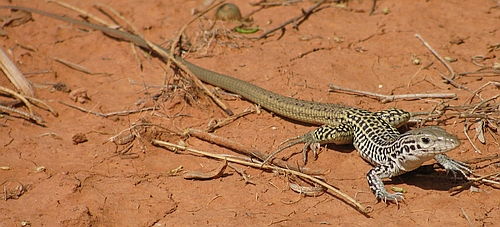Scientists think that fewer than 0.2% of vertebrate species can reproduce with genetic contributions from only one parent, so-called unisexual reproduction. Various modes of unisexual reproduction exist in vertebrates, and certainly obligate parthenogenesis – whereby a female can only produce offspring unassisted by conspecific males – ranks among the most intriguing. Among vertebrates, obligate parthenogenesis exists only within a few clades of squamates (lizards and snakes). For this reason, I use a parthenogenetic lizard system, Aspidoscelis tesselata, to probe how a unisexual vertebrate may generate diversity.
The checkered whiptail lizard, Aspidoscelis tesselata, is hypothesized to be a hybrid lineage between two other whiptail species: A. septemvittata (paternal origin) and A. marmorata (maternal origin). Thus, A. tesselata lineages are hybrid parthenoforms and diploid with one copy of chromosomes from each ancestral ‘parent’ species. This paradigm, combined with our knowledge of phenotypic diversity in A. tesselata, provides a magnificent backdrop to investigate how diversity arises, persists, and can be created in a vertebrate unisexual lineage.
Specific projects include:
- Assignment of A. tesselata individuals of several phenotypes to maternal and paternal lineages. Approached using nuclear and mitochondrial DNA.
- Phylogenetic description of a tightly related species A. dixoni in relation to A. tesselata.
- Assess mitochondrial genome evolution in A. tesselata and other Aspidoscelis. Parthenogenesis could lift certain selective restraints seen in bisexual lineages and permit otherwise poorly fit mitochondrial haplotypes (e.g., large tandem duplications) to persist.

